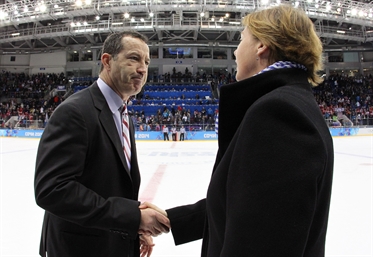Squeezing medals from a Stone
Squeezing medals from a Stone
The black coat and other stories from USA's coach

 The coaches from Canada and the USA, Kevin Dineen and Katey Stone, shake their hands after the preliminary-round encounter. Photo: Andre Ringuette / HHOF-IIHF Images
The coaches from Canada and the USA, Kevin Dineen and Katey Stone, shake their hands after the preliminary-round encounter. Photo: Andre Ringuette / HHOF-IIHF Images
“I had been wearing just a windbreaker," she continued. "It was cold. I didn’t think it looked good. I thought I should look a little bit better on the bench coaching at Harvard, so I ended up with this great coat. I wore it on every game day. It got a little old, so we retired it in Finland last year with the players, and now one of the players gets it after every game - the player of the game - and I got a new one. One, it’s warm. Two, it’s a case of look sharp, you play sharp; look sharp, you coach sharp. There are a few Harvard players who aren’t too happy the national team has it right now, but that’s the way it goes!”
The coat, though, doesn’t make the woman. It’s what’s underneath the coat that matters, and in Stone’s case that’s a combination of hockey smarts, passion, and dedication - to the game and to the players.
Where does it all come from? It’s organic and as natural as any hockey story.
“We had a pond outside our house, and I’m the youngest of four kids, so I had older siblings - two brothers and a sister - who were already skating and playing hockey,” Stone began, looking deep into her past. “By the time I was three, I was out there playing. When I was about seven, I went to my dad and said, ‘I really want to play hockey.’ He was an athletic director and was able to get me all the gear I needed, so one morning at about 5.30 I showed up at a boys practice. They didn’t want to let me on the ice, but I begged them and told them I had all the gear; I wasn’t going to get hurt. And that’s how it started.”
Continue readingFrom the pond in Watertown, Connecticut to high school to the University of New Hampshire, Stone’s love of the game grew and grew, but so did her passion for lacrosse, a game very much like hockey on grass. In fact, Stone played briefly on the U.S. national lacrosse team, something she could never boast about hockey.
“It’s a great game,” she enthused, “so many things you can take from it, anticipation-wise, read-and-react. There are so many similarities to hockey.”
Stone played both sports at UNH, graduating in 1989, but the truth was she anticipated a career in lacrosse more than hockey. “Honestly, I thought I was going to be a lacrosse coach, and then the opportunity at Harvard came and it was too good to pass up,” she related of her beginnings coaching the puck game.
“I was a physical education major. I wanted to be an athletic director and a coach at a private school. That was where I was headed. I worked at three different private schools over a total of six years, and then the job at Harvard came up. I loved the game. I thought it was a great fit, a great challenge, and I’ve been there for 20 years.”
How does a player become a coach at such a young age in a sport she really didn’t have a lot of experience coaching?
“I come from a family of coaches,” she explained. “My dad was an A.D. [athletic director] and a football and baseball coach; every sibling in my family is coaching or has coached. It’s kind of the family business. I have a passion to coach and to teach and to help kids develop. It was a no-brainer for me. I love to go to practice. I love to watch kids get better.”
And so in the fall of 1994, the Stone Age began at Harvard, an epoch of success that has been and continues to be extraordinary. She has become the all-time winningest coach in NCAA Division I history and has led the Crimson to five appearances in the Frozen Four. What is doubly impressive is that she has succeeded in sports in an environment where athletics take a back seat to academics. In other words, only good students need apply.
“I really believe we’ve done it right at Harvard,” Stone said about recruiting, her success, and the program in general. “The high standards, no academic shortcuts, no recruiting shortcuts. We’ve had success. I’m so proud of the players who have come out of the program, the things they do now in life to better others, whether they’re doctors, lawyers or teachers or they’re USA or Canadian hockey players. Giving them opportunities to be successful so they have the tools for life.”
Recruiting has changed for Stone and for every NCAA coach in recent years. While it used to be that many players would send videotapes of their games to “apply” for a scholarship, the women’s game is taken so seriously now that scouts look under every nook and cranny to find talent.
“We don’t do much with tapes now,” Stone said. “We’re out on the road so much, and there are so many opportunities with different tournaments where our staff can get out there. I have two assistant coaches who work really hard at recruiting. I don’t do as much running all over the place as I used to do, which is a nice thing. Sure, we have people in certain places making sure we don’t miss anybody, but so much of it is we have a very high academic standard, so there’s a pretty small pool of players.”
And what exactly is a Katey Stone-Harvard prospect?
“First, we look to see if they’re academic and hockey strong, and then we see if they’re character strong. We build our program on character because very rarely in my 20 years have we had the most talent, but I think we’ve had tremendous character, and that’s helped us be successful.”
Which brings us to the critical question: Stone is true-blue American, hoping to dethrone Canada for Olympic gold here in Sochi, but at Harvard she absolutely has to have a good selection of Canadians on the team if she wants to be successful in the NCAA. Is it easy to separate the Harvard coaching brain from the Team USA brain?
“Absolutely,” Stone enthused. “We want players from all over. We had a Ukrainian woman on our team. If we could get more European players, I’d love it. Harvard is all about diversity. Once I go back to Harvard and put that hat on again, we’re going to go after the best Canadians we can find.”
Until then, however, it’s gloves off and black coat on. Stone is going for gold for the U.S. eh!
Back to Overview







































